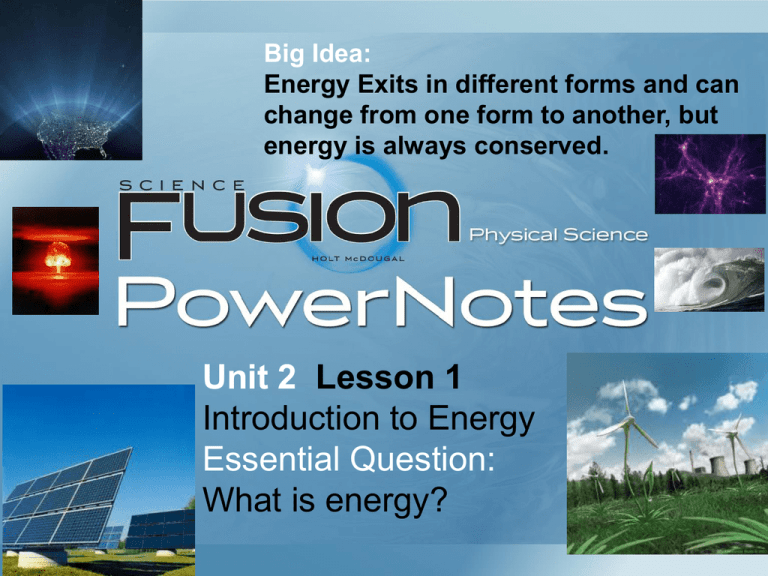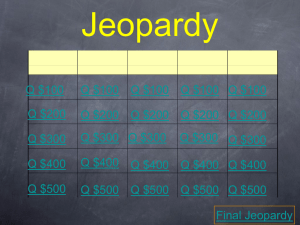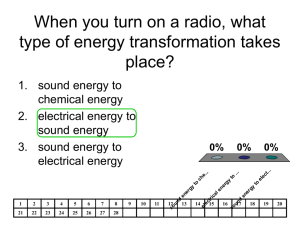Potential energy
advertisement

Big Idea: Energy Exits in different forms and can change from one form to another, but energy is always conserved. Unit 2 Lesson 1 Introduction to Energy Essential Question: What is energy? X X X X Sound from this marching band is caused by vibrations of air particles A law that states that energy cannot be created or destroyed but can change forms Unit 2 Lesson 1 Introduction to Energy Get Energized! p102 What are two types of energy? • Energy is the ability to cause change. • Energy takes many different forms and causes many different effects. • There are two general types of energy: • kinetic energy • potential energy Unit 2 Lesson 1 Introduction to Energy p102 What are two types of energy? • Kinetic energy is the mechanical energy of an object that is due to motion. All moving objects have kinetic energy. • The amount of kinetic energy an object has depends on its mass and speed (Velocity). • Kinetic energy increases as mass increases and as velocity (speed) increases. Unit 2 Lesson 1 Introduction to Energy p103 What are two types of energy? • Potential energy is the mechanical energy that an object has due to its position, condition, or chemical composition. • Potential energy that is the result of an object’s position is called gravitational potential energy. • Gravitational potential energy increases as the object’s height or mass increases. Unit 2 Lesson 1 Introduction to Energy p103 What are two types of energy? • Potential energy is the mechanical energy that an object has due to its position, condition, or chemical composition. • Potential energy that is the result of an object’s condition is called elastic potential energy. • A change in the condition of an object affects its potential energy. • Stretching a rubber band increases its potential energy Unit 2 Lesson 1 Introduction to Energy p103 What are two types of energy? • Potential energy is the mechanical energy that an object has due to its position, condition, or chemical composition. • Potential energy that is the result of an object’s chemical composition is called chemical potential energy. • Chemical potential energy depends on chemical composition. • As bonds break and new bonds form between atoms during a chemical change, energy can be released. Fuels such as charcoal are hydrocarbons, chemical compounds made mainly from hydrogen and carbon. When a fuel burns in air, the hydrocarbons break up into simpler compounds. The chemical potential energy they contain is then released as heat energy. Light energy is produced at the same time and this is what makes a fire glow as it burns Unit 2 Lesson 1 Introduction to Energy p103 6) Other things that show PE & KE Unit 2 Lesson 1 Introduction to Energy p103 Can objects have potential and kinetic energy at the same time? • An object can have both potential and kinetic energy at the same time. The story of kinetic and potential energy Unit 2 Lesson 1 Introduction to Energy p103 7) Analyze: Do you think that the skater has any GPE at pt C (3)? Explain • No, because he is at the bottom of the ramp. • Gravity cannot pull him any lower, so he has no GPE Energy transfer inside a half pipe. 1 & 5) All potential energy 2) Potential becoming Kinetic 3) All Kinetic energy no Potential 4) Kinetic becoming Potential 5) All Potential • The Come-Back Can – Lab Section • Take out key terms and put on corner of desk. • Planner/Yellow card on top of key terms – open to today’s date. • Open book to p104 • Write name on all papers on your desk P104-106 notes In Perfect Form WS (homework) Unit 2 Lesson 1 Introduction to Energy p104 In Perfect Form What forms can energy take? • Kinetic energy and potential energy are two types of energy that can come in many different forms. • mechanical, sound, electromagnetic, electrical, chemical, thermal, and nuclear energy. • Energy is expressed in joules (J). P104-105 Mechanical Energy • • • • Sum of Kinetic and Potential Energy Energy of Position and Motion Moving car Can be all kinetic, all potential or a combination P104-105 Electromagnetic Energy Sound Energy • Kinetic Energy • Vibration of particles of the medium it’s traveling through • Kinetic Energy • Travels through space in electromagnetic waves • Vibrations of electrically charged particles. • Electric and Magnetic Properties • X-rays, microwaves, visible light, sun Electrical Energy • Kinetic and Potential Energy • Position and Motion of charged particles (electrons – negative) • Lights, computer Thermal energy Chemical Energy • Potential Energy • Bonds break and new bonds form. • Food, batteries, matches • Kinetic Energy • Particles are in motion • As motion increases, KE increases, Temperature increases • Heat is energy transferred from the area of higher temp to area of lower temp P104-105 Nuclear Energy • Potential Energy • Nucleus of an atom is the source. • Fission: nucleus splits (breaks apart) • Fusion: Nuclei join together • Energy is released • SUN Unit 2 Lesson 1 Introduction to Energy P104-105 9) How does electrical energy differ from electromagnetic energy? Electromagnetic energy is caused by vibration of electrically charged particles. Transmitted by waves Electrical energy is caused by the position or motion of electrically charged particles. 10) Would you expect to detect electrical energy if you played the pinball game? Explain The pinball machine is powered by electrical energy as inferred by the lights, sounds (rings where the ball hits the bumper) and motion of the flippers. Unit 2 Lesson 1 Introduction to Energy In Perfect Form WS 1) You can determine an object mechanical energy by adding together the objects kinetic and potential energy. 2) 2 forms of energy associated with the particles that make up the object are: Nuclear, electromagnetic, electrical, chemical, thermal or sound. 3) B,C,E,F (electrical, thermal, chemical, electromagnetic) 4) A (mechanical) 5) A,B,C,F (mechanical, electrical, thermal, electromagnetic) 6) B,C,F (electrical, thermal, electromagnetic) 7) C,D,F (thermal, nuclear, electromagnetic) 8) A,C,E,F (mechanical, thermal, chemical, electromagnetic) Unit 2 Lesson 1 Introduction to Energy P104-105 What forms can energy take? 8) What forms of energy can you identify in this pinball game? Electromagnetic B Sound C Mechanical A Copyright © Houghton Mifflin Harcourt Publishing Company Unit 2 Lesson 1 Introduction to Energy Pg 106 12) Why is the chemical energy of a battery potential energy and not kinetic energy? The energy in the chemicals is stored energy. The battery must be placed into a completed electrical circuit for the energy to create an electric current. Unit 2 Lesson 1 Introduction to Energy Pg 108-109 Transformers What is an energy transformation? • An energy transformation takes place when energy changes from one form into another form. • Any form of energy can change into any other form of energy. • Often, one form of energy changes into more than one form. Unit 2 Lesson 1 Introduction to Energy Pg 108-109 What is an energy transformation? • In a flashlight, chemical energy (battery) is transformed into electrical energy. • The electrical energy is then transformed into light and thermal energy. Unit 2 Lesson 1 Introduction to Energy Pg 108-109 Is energy conserved? • A closed system is a group of objects that transfer energy only to one another. Energy is conserved in all closed systems. • The law of conservation of energy states that energy cannot be created or destroyed. It can only change forms. • All of the different forms of energy in a closed system always add up to the same total amount of energy. 17) Relate The law of conservations of energy states energy is not created not destroyed: it can only change forms. An energy transformation is a change from one form of energy to another. Unit 2 Lesson 1 Introduction to Energy Pg 108-109 Energy Transformations when you strike a match? __________ __________ and __________ __________ __________ and __________ Energy Transformations when you bounce a ball? _____ _____ _____ _____ ______________________ _____ _____ Unit 2 Lesson 1 Introduction to Energy Pg 108-109 Energy Transformations when you strike a match? 1) Striking the match transforms mechanical energy to thermal energy & sound energy. 2) Thermal Energy causes particles to release chemical energy. 3) Chemical energy is transformed to thermal and electromagnetic energy. Chemical Potential Mechanical Thermal & Sound Chemical Thermal (heat) & Electromagnetic (light) Unit 2 Lesson 1 Introduction to Energy Pg 108-109 Energy Transformations when you bounce a ball? 1) As the ball falls, gravitational potential energy is transformed to kinetic energy. 2) While the ball is in contact with the floor, kinetic energy transforms into elastic potential energy and then back to kinetic energy. 3) As the ball travels upward, kinetic energy is transformed to potential energy. 4) The ball does not return to original height because some K.E. is transformed to Thermal energy or Sound during a bounce. GPE KE EPE KE Thermal and Sound Energy GPE Unit 2 Lesson 1 Introduction to Energy Space Weather and Technology • Space weather includes any activity happening in space that might affect Earth’s environment. • Space weather can damage satellites and interrupt phone signals and signals to Global Positioning System (GPS) receivers. • Auroras are caused by electrically charged particles of solar winds hitting Earth’s magnetic field. They can interrupt airplane communications. Copyright © Houghton Mifflin Harcourt Publishing Company Unit 2 Lesson 1 Introduction to Energy Space Weather and Technology pg 107 13) Identify: what type of energy is monitored by scientists forecasting future space weather? __________________________________________________________________ __________________________________________________________________ __________________________________________________________________ 14) Infer: Why is space weather a bigger concern now than it was in the past? __________________________________________________________________ __________________________________________________________________ __________________________________________________________________ __________________________________________________________________ 15) Research: How do scientists forecast space weather? Why? __________________________________________________________________ __________________________________________________________________ __________________________________________________________________ __________________________________________________________________ __________________________________________________________________ Copyright © Houghton Mifflin Harcourt Publishing Company Unit 2 Lesson 1 Introduction to Energy Space Weather and Technology pg 107 13) Identify: what type of energy is monitored by scientists forecasting future space weather? __________________________________________________________________ __________________________________________________________________ __________________________________________________________________ 14) Infer: Why is space weather a bigger concern now than it was in the past? __________________________________________________________________ __________________________________________________________________ __________________________________________________________________ __________________________________________________________________ 15) Research: How do scientists forecast space weather? Why? __________________________________________________________________ __________________________________________________________________ __________________________________________________________________ __________________________________________________________________ __________________________________________________________________ Copyright © Houghton Mifflin Harcourt Publishing Company Energy measured in exists as is the ability to do Work can be which at a given rate is Power Draw and fill in into your notes Review Energy exists as Kinetic energy Potential energy measured in is the ability to do Joules Work can be Elastic Gravitational which at a given rate is Power







